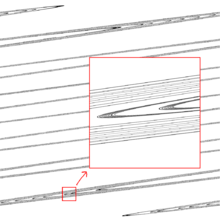Zaslavskii map

Zaslavskii map with parameters: 

The Zaslavskii map is a discrete-time dynamical system introduced by George M. Zaslavsky. It is an example of a dynamical system that exhibits chaotic behavior. The Zaslavskii map takes a point ( ) in the plane and maps it to a new point:
) in the plane and maps it to a new point:
and
where mod is the modulo operator with real arguments. The map depends on four constants ν, μ, ε and r. Russel (1980) gives a Hausdorff dimension of 1.39 but Grassberger (1983) questions this value based on their difficulties measuring the correlation dimension.
See also
References
- G.M. Zaslavskii (1978). "The Simplest case of a strange attractor". Phys. Lett. A 69 (3): 145–147. Bibcode:1978PhLA...69..145Z. doi:10.1016/0375-9601(78)90195-0. (LINK)
- D.A. Russel, J.D. Hanson, and E. Ott (1980). "Dimension of strange attractors". Phys. Rev. 45 (14): 1175. Bibcode:1980PhRvL..45.1175R. doi:10.1103/PhysRevLett.45.1175. (LINK)
- P. Grassberger and I. Procaccia (1983). "Measuring the strangeness of strange attractors". Physica 9D: 189–208. Bibcode:1983PhyD....9..189G. doi:10.1016/0167-2789(83)90298-1. (LINK)
![x_{n+1}=[x_n+\nu(1+\mu y_n)+\epsilon\nu\mu\cos(2\pi x_n)]\, (\textrm{mod}\,1)](../I/m/739c74132705163089d7d48983f54283.png)

